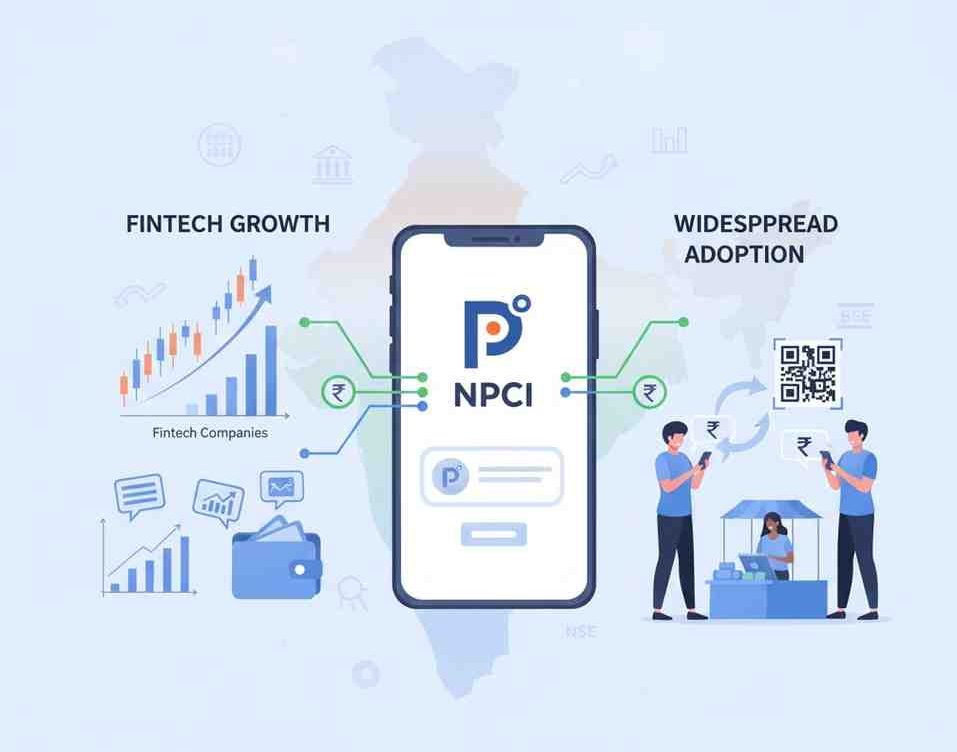
How UPI Growth Influences Fintech Companies Listed in Indian Markets
How UPI Growth Influences Fintech Companies Listed in Indian Markets
In recent years, India’s financial ecosystem has undergone a remarkable transformation, with the Unified Payments Interface (UPI) emerging as one of the most influential forces behind this change. UPI has not only revolutionized the way individuals and businesses transact but has also significantly shaped the performance and strategic direction of fintech companies listed in Indian stock markets.
Thank you for reading this post, don't forget to subscribe!This article explores how UPI adoption has driven fintech sector growth, the broader implications for investors, and how digital payments are influencing the valuation and business models of India’s fintech players.
The Rise of UPI and Its Role in the Fintech Revolution
Launched by the National Payments Corporation of India (NPCI) in 2016, UPI was designed to create a seamless digital payment infrastructure for instant, real-time transfers. Its success has exceeded expectations, with transaction volumes crossing billions every month, supported by increasing smartphone penetration and affordable data connectivity.
The role of UPI in shaping India’s fintech industry is profound. It has provided the backbone for innovation across payment apps, lending platforms, and neobanks. UPI’s open architecture has enabled both established financial institutions and emerging fintech startups to build scalable, user-friendly solutions for consumers and merchants alike.
UPI Adoption Driving Fintech Sector Growth
As UPI became more integrated into daily financial activities, fintech companies leveraged its accessibility to expand their user base and enhance engagement. For payment-focused fintech firms, such as Paytm, PhonePe, and BharatPe, UPI transactions became a core business driver.
UPI’s growth has also fostered innovation beyond payments. Companies offering personal finance management, digital lending, and wealth-tech services have incorporated UPI-based insights to refine credit scoring models and improve customer experience. The impact of UPI growth on fintech companies in India can therefore be seen not only in transaction volumes but also in improved customer retention and product diversification.
For investors, this expansion translates into sustained long-term potential. UPI’s rising adoption ensures recurring transaction-based revenues and contributes to network effects that reinforce market leadership among top fintech companies.
Fintech Companies Listed in Indian Stock Markets: Opportunities and Challenges
The number of fintech companies listed in Indian stock markets has increased in recent years, reflecting investor confidence in the sector’s structural growth. Firms such as Paytm and Fino Payments Bank are publicly traded examples of fintech entities benefiting from UPI integration.
However, the influence of UPI on these companies is multifaceted. While it has accelerated user acquisition and transaction growth, it has also intensified competition, compressing margins. As UPI operates as a zero-merchant-discount-rate (MDR) platform, payment service providers often struggle to monetize pure payment transactions directly.
Consequently, listed fintech companies are shifting their strategies to focus on ecosystem building — offering lending, insurance, investment, and merchant solutions. This diversification helps balance revenue streams and aligns with investor expectations for profitability.
How Digital Payments Influence Fintech Stocks in India
The digital payments landscape in India is now a critical factor influencing the valuation and growth trajectory of fintech stocks. As investors evaluate these companies, metrics such as UPI transaction share, user engagement, and digital ecosystem penetration serve as key indicators of business strength.
The impact of digital payments on fintech stocks in India extends beyond operational data. Market sentiment toward digital transformation and government initiatives supporting cashless transactions also play vital roles. For example, regulatory clarity around data privacy, interoperability, and financial inclusion directly affects investor confidence and long-term valuations.
In this context, fintech firms with diversified digital offerings and strong user retention through UPI-based platforms tend to command higher market premiums.
The Role of Policy and Infrastructure in Sustaining Growth
Government and regulatory support have been instrumental in ensuring UPI’s continued expansion. The Reserve Bank of India (RBI) and NPCI have introduced measures to improve transaction security, encourage innovation, and expand the ecosystem’s reach to rural and semi-urban areas.
Additionally, partnerships between fintechs, traditional banks, and payment aggregators have created a collaborative ecosystem rather than a purely competitive one. This collaboration ensures financial inclusion while promoting steady growth in transaction value and volume.
As India continues to advance toward a more digital economy, this supportive environment is expected to sustain the growth momentum for fintech companies dependent on UPI infrastructure.
Investor Perspective: Evaluating the Impact of UPI on Fintech Valuations
For investors analyzing fintech companies listed on Indian exchanges, understanding the implications of UPI adoption is essential. Companies that effectively integrate UPI into broader product ecosystems — offering lending, investments, or cross-border solutions — are better positioned for stable revenue growth.
However, the long-term outlook also depends on how these companies adapt to evolving regulatory frameworks and market dynamics. Overdependence on UPI-based revenues without adequate diversification could expose them to risks associated with policy changes or technological disruptions.
Thus, investors should assess fintech stocks by examining UPI transaction volumes alongside other indicators such as customer acquisition costs, average revenue per user (ARPU), and cross-selling potential.
Conclusion: UPI as a Catalyst for Fintech Evolution
The impact of UPI growth on fintech companies in India extends beyond just the payments landscape. It has redefined business models, enhanced operational efficiencies, and contributed to the democratization of digital finance.
While the sector faces challenges such as competition and monetization constraints, the long-term outlook remains promising. With UPI continuing to evolve and expand into new areas like credit and cross-border payments, fintech firms that align with this growth trajectory are likely to benefit from enhanced investor interest and sustainable financial performance.
In essence, UPI has become more than a payment system — it is a catalyst for innovation, inclusion, and enduring value creation within India’s fintech sector.
Related Blogs:
How Digital Lending Is Driving Demand for Fintech Stocks in India
Portfolio Diversification with Fintech Stocks in India: What Investors Should Know
Top NBFC Non-Banking Financial Companies Stocks to Invest in India for 2025
Invest in the Future: Top Small-Cap Bank Stocks in India for 2025
Top 5 Fintech Stocks in India
What Makes a Small-Cap Bank Stock a Good Investment?
Understanding Small-Cap Bank Fundamentals: A Guide for Indian Investors
How Digitalization is Transforming Small-Cap Banking in India
Top 5 Finance Stocks in India
Disclaimer: This blog post is intended for informational purposes only and should not be considered financial advice. The financial data presented is subject to change over time, and the securities mentioned are examples only and do not constitute investment recommendations. Always conduct thorough research and consult with a qualified financial advisor before making any investment decisions.

